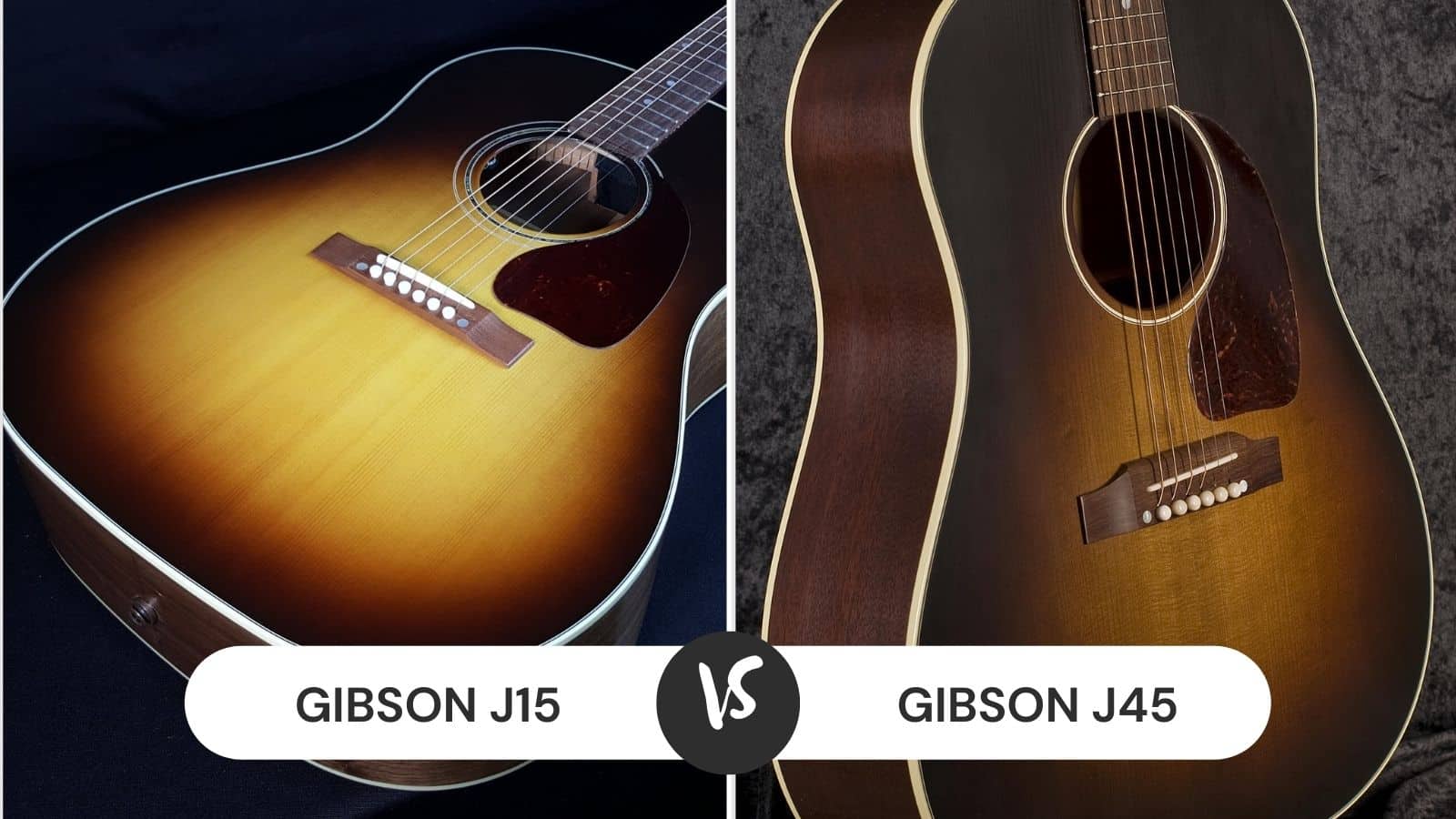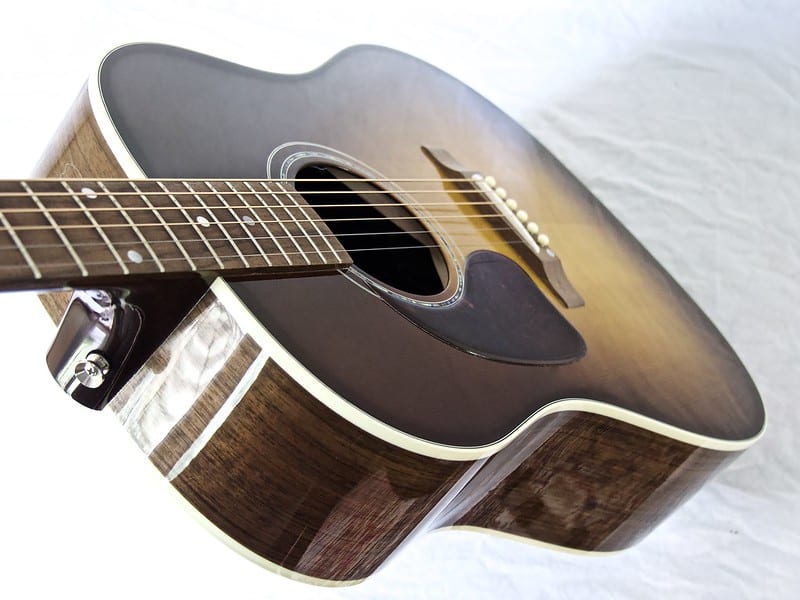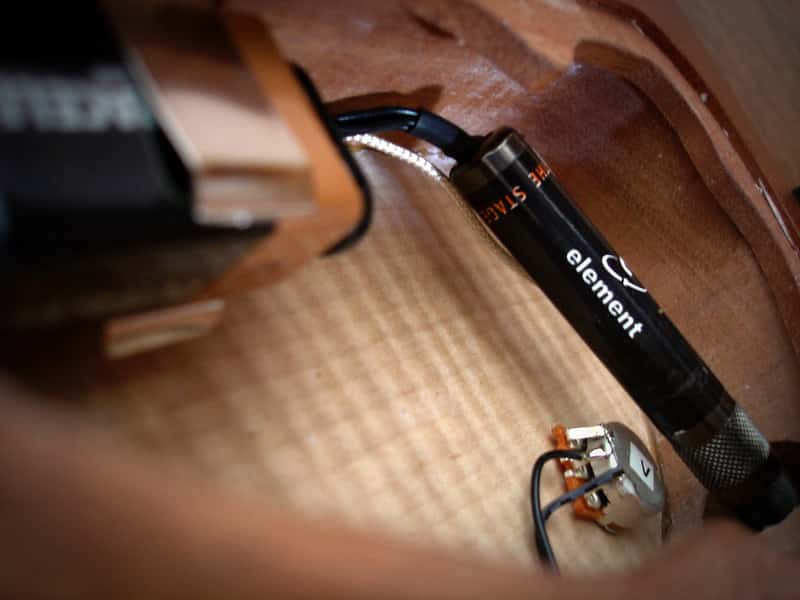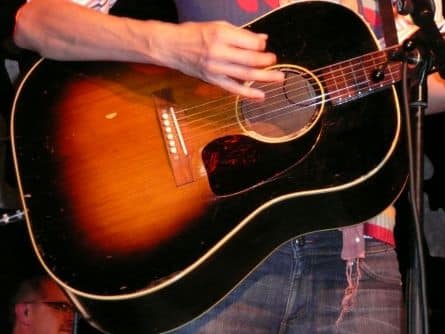
Gibson guitars are considered one of the best out there, thanks to their perfect blend of awesome sound performance, high endurance, and vintage feel. These durable guitars are not only great in looks but they can carry a tune much better than most brands despite being budget-friendly.
To target the high demand, Gibson has released several different models of guitars with different types, materials, and specifications. Because of the abundance and variety, it can be hard to navigate and find the best guitar for your needs.
Two popular options from Gibson are the J15 and the J45, and both are highly recommended by guitarists. However, picking one of the two can be hard as both are quite identical look-wise, and you only notice the differences once you get used to playing them.
But don’t worry, we’re here to help you out in finding the right guitar. We’ve reviewed both the J15 and J45 models and compared them below. So let’s get started!
Gibson J15 vs J45 Guitar
| Features | Gibson J15 | Gibson J45 |
|---|---|---|
| Body and Neck | The guitar has a walnut body with a maple wood neck. | The guitar has a mahogany body and neck. |
| Fretboard | The fretboard is made of walnut. | The fretboard is made of rosewood. |
| Availability | It’s a discontinued model, but can be purchased for around $1800-2000. Cheaper. | The model is in production and new pieces can cost around $2800. Costlier. |
| Bridge | Has a rectangle bridge. | Has a belly-up shaped bridge. |
| Neck | Has a slim-taper-designed neck. | Uses Gibson’s Advanced Response design in the neck. |
| Bass | Has a more ringing tone with deeper bass. | Less booming sound. |
| Tuners | Features Grover Mini Rotomatic tuners. | Features Grover Nickel closed-gear Rotomatic tuners (larger in size). |
| Bracing | Slightly rough interior bracing. | Fine interior bracing in a hand-scalloped X design for better resonance. |
Gibson J15 Guitar
The Gibson J15 is a discontinued guitar that’s no longer in production, meaning you can’t order it from Gibson’s stores. But despite being an old and discontinued release, the J15 remains a popular acoustic guitar that provides you the best value for your bucks.
The J15 is a unique model made with a combination of woods- it has a maple wood neck and a walnut fretboard and body. This elite combo makes the guitar the right balance of sturdy, reliable, and lightweight.
The guitar has a voluptuous and curvy shape with broad round shoulders, making it simpler to handle while sitting, standing, or walking around. The curvy shape plus lightweight wood model makes it easy to carry too.
The J15 has a 24 ¾ inch scale length along with a full-sized dreadnought, making it ideal for adults. The size gives the guitar abundant power and a strong volume with lavish sounds.
The combo of walnut, spruce, and maple neck produces those nice and warm tones that make playing the guitar welcoming. The dreadnought also enables you to switch up between playing the guitar at a moderately loud volume to playing it lightly for a lovely quaint sound.
As for the definition in sound, it’s definitely crystal clear and there’s a luxurious resonance produced by the chords. The guitar gives excellent soulful tunes with a little chime.
There’s a decent amount of sustain and the tone spectrum is mid-range and well-balanced. Playing the right chords can get you unparallel sweetness in the melody.
It’s recommended to play the Gibson J15 by flat-picking or strumming, but the guitar produces fine results with fingerstyle as well. The rich harmonies when strumming or flat-picking are unparalleled when recorded though.
Moving on to the design again, the guitar has a nitrocellulose lacquer layer hand-sprayed for final touches. The lacquer gets warmer and brighter as the guitar ages. The finish is of two types- Antique Natural and Walnut Burst, but both of them are clean and smooth.
The maple neck also has a satin finish with a comfortable taper on the top, making it slim. One small issue though is the unsanded and rough bracing on the inside, which you can notice from the soundhole when playing- it’s a small detail, but it can be annoying for some.
The solid maple neck had a comfortable slim taper profile and a really nice satin finish. We never found ourselves getting hung up on it, even after extended play.
Moreover, if you’re interested in playing the J15 at gigs, you can find an LR Baggs Element placed inside. This element picks up the chords without obstructing the final results. The element comprises a smooth transducer placed beneath a saddle.
This gets rid of unnecessary coupling that may occur between the guitar and the pickup. Gibson has even hidden the volume adjusting knob away and made it sound-hole mounted rather than drilling it in place from the sides to reduce obstruction.
Despite being cheaper than the J45, the Gibson J15 is certainly a quality guitar with no detrimental effect on the final product. If you prefer a more ringing tone, then the J15 is ideal for you. The guitar has excellent fine control and tuning abilities thanks to the Grover Mini Rotomatics tuners.
While the J15 is generally cheaper than the J45, this has definitely not had a detrimental effect on the sound. Many players are actually preferring the ringing tones of the J15 to the J45. The acoustic sound is carried by an exquisite overtone.
The guitar finds its sound somewhere between the modern Taylor guitar and the vintage yet deep Martin. You’ll find a full spectrum containing all kinds of tones, from lofty acoustics to powerful ringing bass.
Gibson J45 Guitar
Moving on to the Gibson J45, it’s another fantastic pick from the acoustic line and unlike the J15, it’s still in production.
The guitar has a different feel thanks to the luxurious mahogany neck and body and a rosewood fretboard (also called the fingerboard) but the looks remain similar (and gorgeous!).
When it comes to the size, the J45 shares its curvy shape and dimensions with the popular J15, the perfect adult size, but not so big that you need big hands and large fingers to strum the chords.
The jumbo guitar looks similar to the Martin dreadnought- however, the shoulders are more sloped and rounded. The curves are also smooth.
Like the J15, the J45 guitar top uses solid Sitka spruce, a material known for providing excellent punch and clarity to the chords. This is accompanied by a mahogany body that remains more reserved and darker. So all in all, besides the body material, the J15 and J45 share a lot of visual appeals.
Let’s quickly list down other important hardware and electronics features now. There’s an L.R. Baggs element on the board lying underneath the saddle- it’s attached to the upper side of the soundhole.
The under-saddle placement doesn’t dampen the tone though- the natural tone is preserved and compressed.
The soundhole has a control setup where you can adjust the volume and manipulate the tone. There are no exterior knobs or dials that will obstruct your playing sessions here. The hardware has a solid interior bracing in a hand-scalloped X design created to increase resonance.
One other thing the J45 has are weighted bridge pins- the extra material on these sustains strings better. There are also Grover Nickel closed-gear Rotomatic tuners in place of mini ones. They’re pretty easy to operate and fine-tune, keeping your tuning precise and stable.
As for the sound, the J-45 is pretty unique in that it focuses on treble and mid-range tones than large and loud acoustics. The mahogany is smooth and controls booming.
It’s as versatile as the J15 and you can definitely make this brighter guitar do the lead work at gigs. The treble range is much enhanced in the J45.
The J45 is wonderful for playing at gigs too- there’s a little dampening, but it’s not a deal-breaker. You only notice this when you abruptly cut off the chords a lot. An outboard mic will sound better if you only play by strumming.
So in short, if you want a well-balanced and versatile guitar with a luxurious and warm feel, the J45 is definitely for you.



